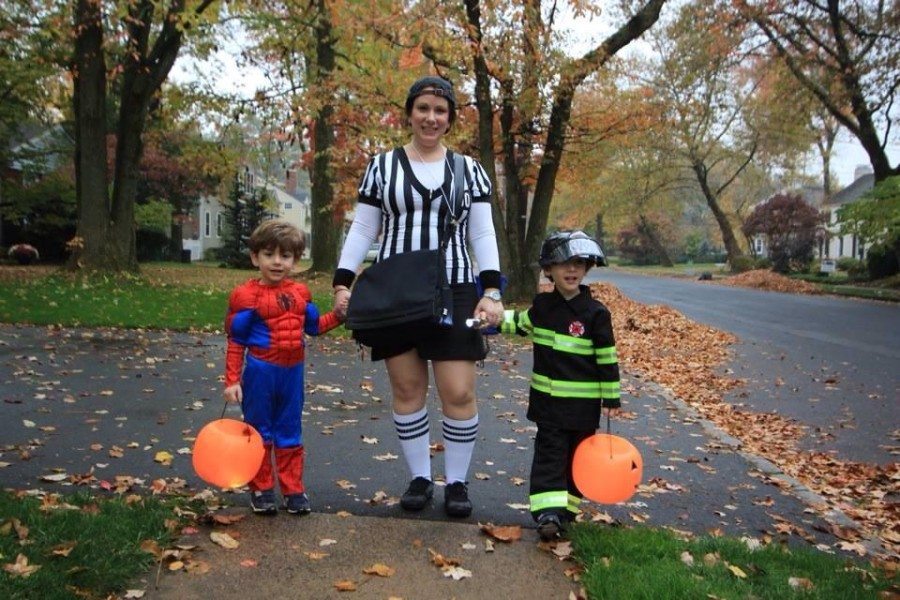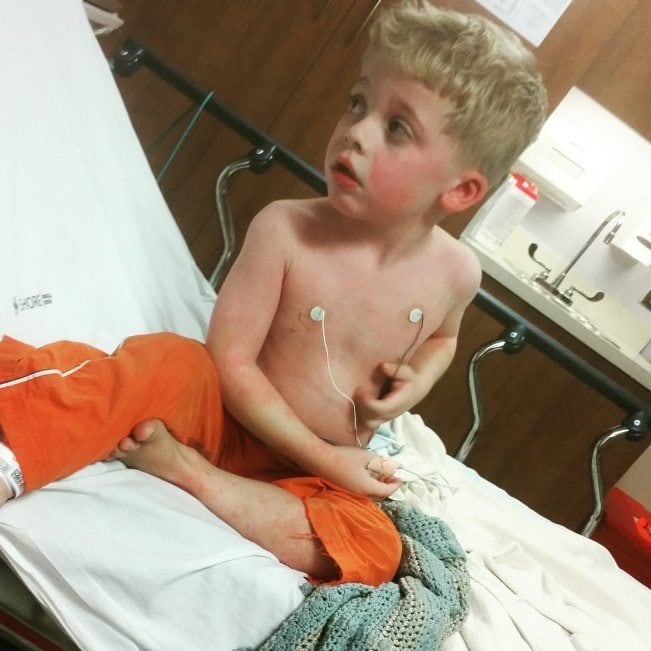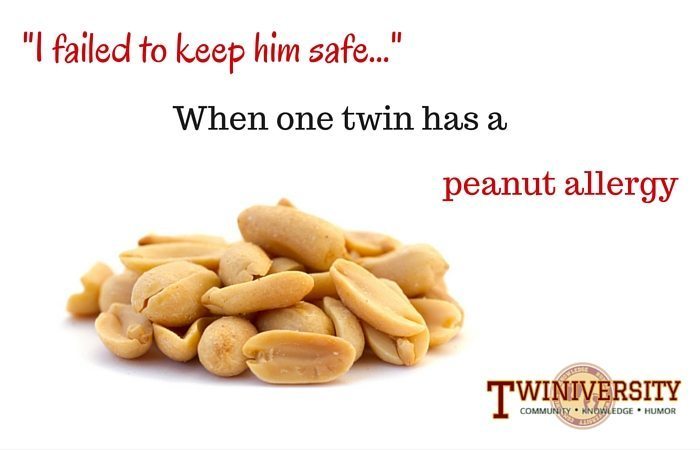Last updated on February 5th, 2024 at 01:10 pm
What happens when one twin has food allergies? A severe, life-or-death peanut allergy, and the other doesn’t? In our house, on the surface, it looks like any other crazy, happy, messy house where twin boys live. But if you look a little closer you will find a supply of Benadryl, epi pens, and sunflower butter instead of peanut butter. You won’t find anything made with peanuts or tree nuts. You will see a “safe” shelf in our cabinet. If you see my kids at school, you will see one is wearing a bracelet to remind his teachers that he can’t come in contact with peanuts.
His babysitters and grandparents are carefully reminded of the right dosage of Benadryl and a refresher course in using the epi pen each and every time he is in their care. If you look inside my purse you will find another epi pen, another bottle of Benadryl and a list of the closest hospitals in the area. When you see me at the grocery store and I am reading every ingredient label like it’s War and Peace, it’s because I can’t run the risk of bringing something deadly home. When we head out to eat it is always the same three places. At home and inside the places we frequent, it is a smooth, almost forgettable disease.
It’s the outside world that scares me. We have had a few close calls in the three years since my son was diagnosed with a peanut and egg allergy. My boys are four and a half. Both boys practice a no-peanut rule, despite only one actually being allergic. Cross contamination is not something we want to risk and neither boy wants to make Alex sick. We thought we did everything right. We thought three years in, we had a pretty good system going. We were wrong.

Halloween is a scary holiday for kids with food allergies. I suspect it is even scarier for the parents. We talked every day leading up to Halloween what the rules were:
- No eating candy before Mommy and Daddy check it.
- No eating candy you haven’t eaten before.
- Do not accept candy from anyone but Mommy and Daddy.
- Do not share candy with your cousins.
- Wait for Mommy and Daddy to okay all candy.
Every night we talked about why we have these rules (to keep Alex safe) and why it is so important to follow these rules (so Alex didn’t get sick). I thought they understood. I was wrong. I was so very wrong.
Halloween came on a Saturday this past year (it also happens to be both mine and my husband’s birthday.) We celebrated with an early lunch and cocktails at the mall followed by some trick or treating with several fire departments. All was going well. All of the candy the twins received was approved and they ate it on the way home. We came home and got a little nap in, and prepared to head to our cousin’s house to do some real trick or treating. It was going smoothly.
We traveled around the neighborhood laughing and listening to the screams of hundreds of children. It was exactly as Halloween was supposed to go. My kids bags were so full of candy, they requested we hold them on the walk back to the house. At no point did my child leave my sight. Let me repeat that — at no point was my peanut-allergy kid alone with the heavy sack of candy he collected from the neighbors. Which makes the mystery of how we ended up in the emergency room all the more confusing.

As I sat at the kitchen table with my husband sorting through safe and unsafe candy, Alex was happily playing in the playroom with his twin brother and his cousin. He casually walked into the kitchen and said he was thirsty. I gave him some of my water and he promptly threw up. I assumed it was a sugar overload. I cleaned him up and gave him another sip of water, finished sorting his candy, and thought nothing of it. After the second time he threw up, it was time to head home — clearly he was coming down with the stomach bug that had been going around. As we stopped for gas I got out to take a quick look at him, just to be certain he wasn’t having an allergic reaction. I pulled up his pants and hives were covering every inch of his perfect little leg.
We rushed to the closest hospital and he was taken right in. In the three years since his diagnosis, he never needed an IV until now. As we started to explain it must have been some kind of cross contamination, he stopped us and said, “No. I ate a chocolate bar with some kind of marble in it.” My heart sank. It sank right down into the bottom of my stomach. What? How? Why? What?? As he laid there, beet red, struggling to not throw up, I cried. I failed. I failed to keep him safe. Every precaution, every conversation, still resulted in all of us, here. Here in this hospital. Luckily, the hives hadn’t compromised his breathing. But his little body was working overtime to rid itself of the poisonous peanut that he ingested.

Meanwhile, his twin brother, Ben, was giving the hospital staff updates: his legs don’t look so red; he’s not throwing up anymore; he is talking to me. Ben took this experience as a lesson. Not just for Alex but himself too. Now, in addition to Alex, we have Ben reminding caregivers, babysitters, and family members of Alex’s allergies. They work together to keep Alex safe. We all work together to keep Alex safe. The mystery still remains when he got ahold of the peanut chocolate bar, and why he decided to eat it, but in the end it was a learning lesson for both boys. A lesson I wish I could have better prevented.
It’s so much more than me protecting my child. It’s also a lesson on how we teach each other. It’s about protecting one another. This may not affect someone in your house, however you almost certainly know someone it does affect. Peanut and food allergies are on the rise, and no one is sure why. Educating ourselves on food allergies is one step we can all take to keep all of our children safer.
What You Might Not Know about Food Allergies
- Teenagers and young adults with food allergies are at the highest risk of fatal food-induced anaphylaxis.
- Eight foods account for 90 percent of all reactions: milk, eggs, peanuts, tree nuts, soy, wheat, fish and shellfish. Even trace amounts of a food allergen can cause a reaction.
- Initially mild symptoms that occur after ingesting a food allergen are not always a measure of mild severity. In fact, if not treated promptly, these symptoms can become more serious in a very short amount of time, and could lead to anaphylaxis.
- This potentially deadly disease affects 1 in every 13 children (under 18 years of age) in the U.S. That’s roughly two in every classroom.
- Food allergies result in more than 300,000 ambulatory-care visits a year among children under the age of 18. Food allergy is the leading cause of anaphylaxis outside the hospital setting.
- Peanut and tree nut allergies, which also tend to develop in childhood, usually are lifelong. In the U.S., approximately three million people report allergies to peanuts and tree nuts. Studies show the number of children living with peanut allergy appears to have tripled between 1997 and 2008.
What Is Anaphylaxis?
- Anaphylaxis is a serious allergic reaction that typically comes on quickly and may cause death. This medical emergency requires immediate treatment and then follow-up care by a doctor. Many people may not realize they have an allergy until they experience anaphylaxis. An allergist can examine you and make a proper diagnosis. If warranted, your doctor will prescribe epinephrine (epi pen) to use in an emergency.
- Anaphylaxis is triggered when the immune system overreacts to a usually harmless substance (an allergen such as peanut or penicillin) causing mild to severe symptoms that affect various parts of the body. Symptoms usually appear within minutes to a few hours after eating a food, swallowing medication or being stung by an insect.
- Anaphylaxis requires immediate medical treatment, including using the epi pen and taking a trip to a emergency room. If it isn’t treated properly, anaphylaxis can be fatal. Sometimes symptoms go away, and then return a few hours later, so it is important to take these steps as soon as an anaphylactic reaction begins and to remain under medical observation for as long as the reaction and symptoms continue.
Know the Signs of Anaphylaxis
- Breathing: wheezing, shortness of breath, throat tightness, cough, hoarse voice, chest pain/tightness, trouble swallowing, itchy mouth/throat, nasal stuffiness/congestion
- Circulation: pale/blue color, low pulse, dizziness, lightheadedness/passing out, low blood pressure, shock, loss of consciousness
- Skin: hives, swelling, itch, warmth, redness, rash
- Stomach: nausea, pain/cramps, vomiting, diarrhea
- Other: anxiety, feeling of impending doom, itchy/red/watery eyes, headache, cramping of the uterus
The most dangerous symptoms are low blood pressure, breathing difficulty and loss of consciousness, all of which can be fatal. If you have any of these symptoms, particularly after eating, taking medication, or being stung by an insect, seek medical care immediately (call 911). Don’t wait to see if symptoms go away or get better on their own.

Laura Birks is a freelance writer and essayist. She lives in New Jersey with her twin boys, a dog, a couple of cat and a husband. When she’s not doling out medicine or cleaning up vomit, she is writing. Her house is in a constant state of disarray and the laundry is never put away. She likes to pretend she is superwoman but the truth is, she is a mere mortal with a messy house. Find her on Twitter, Instagram and Pinterest.
Related Articles
- Into the World with Food Intolerances
- What’s in Your First Aid Kit?
- Lunch Ideas for Picky Kids and Dairy Allergies
Sources: Foodallergy.org, FDA website







